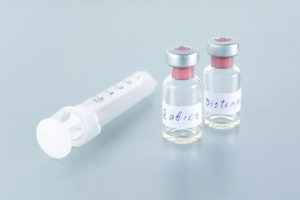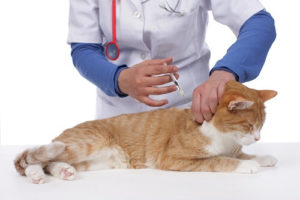Why Vaccines Are Important for Your Pet
It is absolutely critical to get your pet vaccinated to prevent them from suffering from highly contagious and deadly diseases. In fact, aside from providing your pet with food and water, keeping up with regular core vaccines is the most essential thing you can do for your pet.
While we understand that every pet is different, and has different veterinary recommendations in regard to vaccination status, we want to emphasize the importance of vaccinations and why they are required. Our goal is to provide the best experience for your furry family members and all of our guests while staying in compliance with state and local ordinances regarding pet immunizations.
Worth noting is that vaccines have become more effective and safer over the years, with most adult vaccines for pets now lasting for 1 or 3 years. There are several vaccines considered “core” because they immunize pets against the most dangerous diseases. “Non-core” vaccines can be considered optional, depending on your pet’s lifestyle.
All pets share different risks; therefore, their health care is more individually tailored for them.
At Greenlin, we take the health and safety of our guests more seriously than anything. That includes your own pet’s. To protect your beloved family member, and everyone else’s, we require rabies vaccinations for both dogs and cats, and our canine guests must be current on their vaccinations for distemper and Bordetella.
The risks of not being current on vaccinations are serious and can have fatal consequences. Read on to learn in more detail about the vaccines we require and some others that may be recommended by your vet.
Rabies
Rabies is a viral disease that results in death 100% of the time in animals, and it can be easily transmitted to humans. That makes it a priority for state and local agencies to actively track transmissions and try to prevent them with mandatory rabies vaccinations for all dogs and cats.
Transmission usually occurs when an infected animal’s saliva enters through wounds and cuts. After an initial incubation period, the disease will start to attack the pet’s brain and nervous system, resulting in proverbial “rabid animal” behaviors.
Most worrisome, rabies can be transmitted when you least expect it. Even if you take care to limit your pet’s exposure, rabid animals can appear out of the blue on your back porch or during a walk. Consider that when a rabid fox was recently spotted on the U.S. Capitol grounds, several people including a lawmaker and a journalist were bitten, despite best efforts to prevent it.
Any unvaccinated pet that bites another animal requires, at very least, a 10-day quarantine period to monitor for signs of rabies. Any unvaccinated pet that bites a human will be euthanized. That is because the animal must be tested for rabies, which requires taking brain tissue samples through a procedure that no animal could possibly survive.
The state of Pennsylvania records an average of 350-500 confirmed rabies infections in animals each year. Any animal with vertebrae can contract rabies, but it is commonly found in wild raccoons, bats, cats, and skunks. To prevent the disease’s spread, rabies vaccinations are mandatory for all dog and cat owners in Pennsylvania. Non-compliance can result in a $300 fine and an animal welfare report.
What’s at Stake?
We do not exaggerate when we say that a full-blown rabies infection feels like something that’s straight out of a horror movie. Symptoms of an infection start off mildly, similar to a bad cold or the flu. Things go downhill quickly from there.
Rabies affects the nervous system resulting in aggression, confusion, agitation, hypersalivation, inability to swallow, etc. Once the virus is contracted, there is no treatment, and the animal will die, usually within 5 days of developing clinical signs
During the period where the animal presents outward symptoms, the pet poses a severe public health risk, too. A single scratch or nip to a human is enough to require that person to get an extremely expensive series of shots. Prompt treatment can prevent the infection from taking root, but if it is delayed the infected person may die. Cases of possible transmission must also be reported and tracked by the local department of health and other entities. It’s 100% serious business across the board, to put it simply.
When to Vaccinate
Rabies cases in pets are extremely tragic, but they are also easily avoidable. A simple shot is all it takes to immunize an adult pet for a year or more at a time.
Pennsylvania law requires all dogs and cats to be vaccinated against rabies between 12 and 16 weeks of age. A year later, a 1-year booster is administered followed by 1-year or 3-year rabies vaccines thereafter.
The cost of each shot is typically around $30-$60, not counting any exams or other vet visit fees. Some shelters and other organizations are willing to provide low-cost or free vaccinations. Considering that the costs of treatment for a human who has been exposed to rabies start at $3,000 and go upwards of $30,000, the cost of a pet rabies vaccine is quite a good deal!
Distemper
Canine distemper is another scary disease that, in many respects, could be a greater cause for concern than rabies. On the one hand, the disease is far less deadly and much more treatable in animals. Plus, it’s extremely rare for a case to be transmitted to humans. On the other hand, it takes almost no contact at all for the distemper to spread. That’s because it is transmitted through the air via aerosolized saliva and other droplets. Animals coughing, or even just barking, can cause an entire population to be infected almost all at once.
Animal populations in close contact with one another are at extreme risk for rapid distemper spread. In wildlife, that means that animals that live in colonies or family groups are highly susceptible, especially juvenile animals since they lack fully developed immune systems.
Raccoons, foxes, skunks, and coyotes are the most likely wild animals to contract the disease, which then typically spreads rapidly throughout localized populations. Infected wildlife may be seen behaving erratically, such as animals that are normally shy and nocturnal sleeping in public in broad daylight, walking in erratic circles, or chewing upwards at the sky.
Of particular concern is the fact that light or indirect contact with wildlife can lead to transmission. Any contact with animal fluids, including droplets left behind from breathing or coughing, can spread distemper. Pets may even develop distemper if they inadvertently share an outside water bowl with any infected wildlife.
What’s at Stake?
Once distemper finds its way into an animal population, it can spread like wildfire. As you might imagine, this makes animal shelters and boarding facilities extremely wary of any possible outbreaks.
Possible infection or exposure means that all at-risk animals must be quarantined and monitored. Pathogens can even be transmitted from the clothing of people exposed to infected animals, in some cases, so shelter workers must often be separated into groups to avoid accidentally exposing healthy animals. In dire cases, shelters must euthanize large groups of infected, unadopted dogs to stop the spread throughout the community.
There are no direct treatments for distemper once an animal is infected. The best veterinary care providers can offer is to address the symptoms and hope the animal’s immune system can fight off the infection on its own. In addition to respiratory distress, symptoms include fever, nasal and eye discharge, vomiting, and diarrhea. These collectively make the animal extremely dehydrated, requiring fluids to be administered several times a day.
The disease also affects the nervous system, leading to strange and erratic behaviors that superficially resemble rabies infection. Animals infected with canine distemper may walk in circles, tilt their head towards the sky, convulse, “chew” at the air, and be unable to respond to situations as they normally would. In cases where the animal recovers from an infection, it may sustain permanent nervous system damage.
Even once an animal has recovered, it can continue to shed the virus for months at a time, meaning animals are often put on extended quarantine.
When to Vaccinate
Immunocompromised pets, such as puppies, are most susceptible to distemper. For this reason, puppies are vaccinated for distemper between 6-8 weeks old, with these shots repeated every 3-4 weeks until they are 16 weeks old. After their initial vaccine series, pets are vaccinated every 1-3 years, depending on their previous vaccine status.
All dogs visiting or being boarded at Greenlin facilities are required to be current on their distemper vaccinations.
Bordetella
“Kennel cough” is a term that can broadly describe any infectious disease that affects the trachea or mainstem bronchi in dogs. Kennel cough cases are scary because, even though some cases may be mild, they will last for weeks at a time. A dog infected with any form of kennel cough will also be highly contagious to others, especially when housed in a close population with other dogs, such as a multi-dog home or a shelter.
While many different viruses and bacteria can cause or contribute to kennel cough symptoms (including adenovirus type-2, parainfluenza virus, and canine coronavirus), the one of most-concern is Bordetella bronchiseptica. That’s because it can spread rapidly between dogs, including through direct contact or breathing airborne droplets from infected dogs coughing and sneezing. Infected dogs can also sometimes transmit the disease through their bodily fluids, which can easily contaminate shared toys, bowls, or bedding.
What’s at Stake?
While not nearly as life-threatening as rabies or distemper, Bordetella infections result in a chronic cough that is highly transmissible to other pets. Infected dogs will have a loud, distinctive “honking” cough that can last for weeks at a time. During this period, the animal can easily spread the disease to others.
Adult pets usually respond well to treatment. However, juveniles are susceptible to fatal infections, and older dogs are at risk of developing chronic bronchitis. Many cases can also develop into pneumonia, sometimes requiring intensive treatment to keep the animal stable and breathing, as well as antibiotics and other medications.
Overall, the most concerning aspect of Bordetella is how easily it spreads, especially among unvaccinated animals. A single case in a public facility can result in waves of exposure that take months to subside. During outbreaks, infected animals suffer, owners suffer, and the entire community must take extended precautions until infections resolve and case numbers wind down.
Because of the highly contagious nature of Bordetella infections, all dog guests at Greenlin Pet Resorts are required to be current on their Bordetella vaccinations.
When to Vaccinate
Puppies have undeveloped immune systems and are, therefore, highly susceptible to fatal Bordetella infections. Even though Bordetella vaccines are considered “non-core” and optional depending on your dog’s routine, vets recommend that every puppy receive a Bordetella vaccine between 6-8 weeks of age.
Once a puppy has reached maturity, your vet will ask you about their routine before recommending more Bordetella boosters. They will recommend boosters to dogs who regularly share spaces with other animals, especially at public places like dog parks, groomers, dog daycare, or dog boarding facilities. Boosters are often recommended every 12 months for dogs that frequent these spaces — sometimes as often as every 6 months in certain situations. Boosters may also be recommended even if the dog rarely comes into contact with other canines, depending on known risk factors.
Note: The distemper vaccine is typically also combined with vaccines for parvovirus and hepatitis, sometimes including parainfluenza, as well.
Other Suggested Vaccinations
It is important to note that vaccines are split into core and non-core vaccines. Core vaccines are necessary for all pets regardless of lifestyle; while non-core vaccines are not necessary for all pets and are dependent on their lifestyle.
The following vaccines are not required to be current in order for your dog (or cat) to stay at Greenlin, but they are frequently recommended by veterinarians:
Core Vaccines for Dogs
Parvovirus
Parvovirus is a highly destructive disease that is shed in feces and causes cellular destruction of the digestive tract. This is a highly contagious disease that can be fatal if not treated appropriately. Vaccines are recommended to be started between 6-8 weeks of age and boostered every 3-4 weeks until 16 weeks old. Thereafter, pets are vaccinated every 1-3 years depending on their current vaccine status.
Please note that the parvovirus vaccine is included in combination with the distemper and hepatitis vaccination.
Canine Hepatitis
Infectious canine hepatitis affects the liver, but can also lead to other respiratory and digestive signs. The disease usually spreads via exposure to urine or discharge from infected animals. It is important to note that there is no cure, only treatment for symptoms.
Vaccines are recommended to be started between 6-8 weeks of age and boostered every 3-4 weeks until 16 weeks old. Thereafter, pets are vaccinated every 1-3 years, depending on their current vaccine status.
Please note that the hepatitis vaccine is included in combination with the distemper and parvovirus vaccination.
Core Vaccines for Cats
Feline Panleukopenia (FP)
Also known as feline distemper, this disease is spread by the feline parvovirus and primarily affects kittens. This disease causes destruction of the cats’ white blood cells and GI signs and can result in death if not treated appropriately. Vaccines are recommended to be started between 6-8 weeks of age and boostered every 3-4 weeks until 16 weeks old. Thereafter, pets are vaccinated every 1-3 years depending on their current vaccine status.
Feline Calicivirus
This disease starts off with moderate respiratory symptoms but then quickly begins to cause sores to develop in the cat’s mouth and on their face. The disease is highly contagious, especially in places with strays or where multiple cats from different households come into contact. Kittens are given a series of vaccines from 6-8 weeks then every 3 -4 weeks until 16 weeks old. Adult cats will receive boosters every 1-3 years, as recommended by your vet.
Feline Herpesvirus-1
This form of the herpes virus is unique to cats and can result in respiratory infections, eye inflammation, and other symptoms. Once an animal is infected, the disease remains dormant (latent), until a “flare-up” is triggered.
Unfortunately, this disease can still be spread even among vaccinated adults, but the good news is that vaccines reduce the likelihood of severe cases, especially among kittens. Even if your cat has been exposed or diagnosed with herpesvirus-1, it is important to keep up with regular boosters according to your vet’s recommendations. These will reduce the risk of more-severe flareups or transmission to other pets.
Vaccines are given to kittens as early as 6 weeks of age, then once every 3-4 weeks until 16 weeks. From then on, cats should receive boosters every 1-3 years.
Note: Vaccines for Feline Panleukopenia (FP), Calicivirus, and Herpesvirus-1 are often administered as a single “combo” dose.
Feline Leukemia Virus (FeLV)
Like leukemia in humans, FeLV affects a cat’s ability to produce blood cells, including infection-fighting white blood cells. “FeLV depresses the immune system and tends to lead to persistent infection,” says VCA Animal Hospitals. Infected cats may also develop one or more forms of cancer.
Unlike leukemia in humans, FeLV is transmissible. The infection spreads through contact with bodily fluids, which can include through shared bowls or in close-contact settings. Once infected, there is no cure, and the infected cat will require special care and support to manage its highly susceptible immune system, often still resulting in premature death.
Vets now recommend two doses, 3-4 weeks apart, starting at 6-8 weeks of age. Following the second dose, the cat should be boosted after another 12 months. Your vet may then recommend boosters every 2-3 years in most situations unless your cat is at minimal risk.
Non-Core Vaccines for Dogs
- Canine influenza
- Lyme disease
- Leptospirosis
Non-Core Vaccines for Cats
- Chlamydia
Please Let Us Know Your Questions and Concerns
Greenlin Pet Resorts aims to provide the absolute best experience for your furry family members and all of our guests, especially when it comes to their health and safety. Preventing the spread of diseases is an utmost concern for us while staying in compliance with state and local ordinances regarding pet immunizations.
We understand that immunizations have become a sensitive issue in healthcare, and we are willing to hear your concerns and accommodate your pet’s needs when we are able to do so in a reasonably safe manner. At Greenlin, we do not use a “one size fits all” approach. We look forward to speaking with you in detail about yourself and your pet prior to them receiving approval for services to ensure we can accommodate them in the best way possible. Please give us a call to start the process!
Our trained, knowledgeable staff is ready and waiting to welcome your pet! We provide pet boarding, dog daycare, dog training, and more. Please contact us with any questions or concerns or to tour one of our five award-winning pet facilities in the Harrisburg area.




